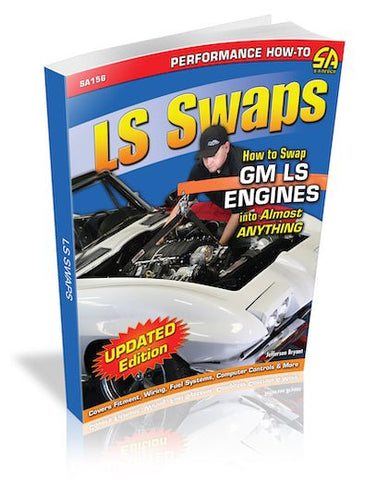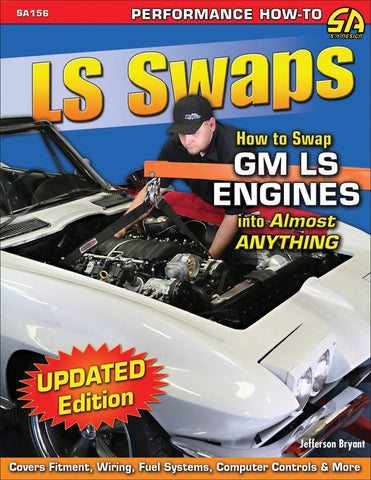To select the best engine for an LS engine swap, you need to carefully consider the application. Veteran author and LS engine swap master Jefferson Bryant reveals all the criteria to consider when choosing an LS engine for a swap project. You are guided through selecting or fabricating motor mounts for the project. Positioning the LS engine in the engine compartment and packaging its equipment is a crucial part of the swap process; it is comprehensively covered. As part of the installation, you need to choose a transmission crossmember that fits the engine and vehicle as well as selecting an oil pan with adequate ground clearance that has the correct profile for the crossmember. Often the brake booster, steering shaft, accessory pulleys, and the exhaust system present clearance challenges, so this book offers the best options and solutions. In addition, adapting the computer-control system to the wiring harness and vehicle is a crucial aspect for completing the installation, and is thoroughly detailed.
As an all-new edition of the original top-selling title, LS Swaps: How to Swap GM LS Engines into Almost Anything covers the right way to do a spectrum of swaps. So, pick up this guide, select your ride, and get started on your next exciting project.
Acknowledgments
Introduction
Chapter 1:
What You Need to Know about LS-Series Engines
Gen III: A Revolution in V-8 Performance
Gen IV: Improving the Legend
Feature Vehicle: 1996 Nissan 240SX SE
Chapter 2:
Engine and Driveline
Motor Mounts
Adapter Plates
Transmission Mounts
Choosing a Driveline
Feature Vehicle: 1967 Corvette C2 Stingray
Chapter 3:
Oil Pan
Stock Oil Pans
Aftermarket Gen III/IV Oil Pans
Oil Coolers
Feature Vehicle: BMW E36
Chapter 4:
Accessory Drives and Cooling System
Stock Accessory Drives
GM Vehicles
Ford Mustangs
Nissan 240SX
Jeep CJ, YJ, TJ, XJ
Mazda Miata, RX-7
Cooling System
Feature Vehicle: Gen III Jeep YJ
Chapter 5:
Transmission and Clutch
Automatic Transmissions
T56 Manual Transmission
Tremec TKO Manual Transmission
Aftermarket Kits
Feature Vehicle: Tri-Five Chevy
Chapter 6:
Wiring Harness and Wiring
Wiring Harness Basics
Wiring a Classic Corvette
1999–2000 LS1 PCM Plug 1
1999–2000 LS1 PCM Plug 2
Connectors for 1997–1998 LS1 Engines
Relays for 1997–1998 LS1 Engines
Connectors for 1999–2002 LS1 Engines
Relays for 1999–2002 LS1 Engines
Aftermarket Harnesses
Feature Vehicle: Volvette: A Corvette-Engined Volvo
Chapter 7:
Engine Management Systems, Tuning Software and Controllers
Reluctor Types
ECM Programming
ECM Tuning Packages
Aftermarket Engine Management
Feature Vehicle: 1967 Chevy Pickup
Chapter 8:
Fuel Systems
In-Tank Fuel Pump
External Fuel Pump
Cavitation
Wiring
Return Lines
Feature Vehicle: 1966 Mustang
Chapter 9:
Exhaust Systems
Exhaust Manifolds
Headers
Feature Vehicle: 1932 Ford Coupe
Source Guide
To select the best engine for an LS engine swap, you need to carefully consider the application. Veteran author and LS engine swap master Jefferson Bryant reveals all the criteria to consider when choosing an LS engine for a swap project. You are guided through selecting or fabricating motor mounts for the project. Positioning the LS engine in the engine compartment and packaging its equipment is a crucial part of the swap process; it is comprehensively covered. As part of the installation, you need to choose a transmission crossmember that fits the engine and vehicle as well as selecting an oil pan with adequate ground clearance that has the correct profile for the crossmember. Often the brake booster, steering shaft, accessory pulleys, and the exhaust system present clearance challenges, so this book offers the best options and solutions. In addition, adapting the computer-control system to the wiring harness and vehicle is a crucial aspect for completing the installation, and is thoroughly detailed.
As an all-new edition of the original top-selling title, LS Swaps: How to Swap GM LS Engines into Almost Anything covers the right way to do a spectrum of swaps. So, pick up this guide, select your ride, and get started on your next exciting project.
Acknowledgments
Introduction
Chapter 1:
What You Need to Know about LS-Series Engines
Gen III: A Revolution in V-8 Performance
Gen IV: Improving the Legend
Feature Vehicle: 1996 Nissan 240SX SE
Chapter 2:
Engine and Driveline
Motor Mounts
Adapter Plates
Transmission Mounts
Choosing a Driveline
Feature Vehicle: 1967 Corvette C2 Stingray
Chapter 3:
Oil Pan
Stock Oil Pans
Aftermarket Gen III/IV Oil Pans
Oil Coolers
Feature Vehicle: BMW E36
Chapter 4:
Accessory Drives and Cooling System
Stock Accessory Drives
GM Vehicles
Ford Mustangs
Nissan 240SX
Jeep CJ, YJ, TJ, XJ
Mazda Miata, RX-7
Cooling System
Feature Vehicle: Gen III Jeep YJ
Chapter 5:
Transmission and Clutch
Automatic Transmissions
T56 Manual Transmission
Tremec TKO Manual Transmission
Aftermarket Kits
Feature Vehicle: Tri-Five Chevy
Chapter 6:
Wiring Harness and Wiring
Wiring Harness Basics
Wiring a Classic Corvette
1999–2000 LS1 PCM Plug 1
1999–2000 LS1 PCM Plug 2
Connectors for 1997–1998 LS1 Engines
Relays for 1997–1998 LS1 Engines
Connectors for 1999–2002 LS1 Engines
Relays for 1999–2002 LS1 Engines
Aftermarket Harnesses
Feature Vehicle: Volvette: A Corvette-Engined Volvo
Chapter 7:
Engine Management Systems, Tuning Software and Controllers
Reluctor Types
ECM Programming
ECM Tuning Packages
Aftermarket Engine Management
Feature Vehicle: 1967 Chevy Pickup
Chapter 8:
Fuel Systems
In-Tank Fuel Pump
External Fuel Pump
Cavitation
Wiring
Return Lines
Feature Vehicle: 1966 Mustang
Chapter 9:
Exhaust Systems
Exhaust Manifolds
Headers
Feature Vehicle: 1932 Ford Coupe
Source Guide










